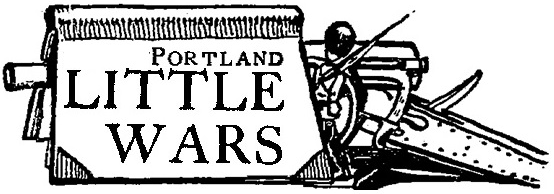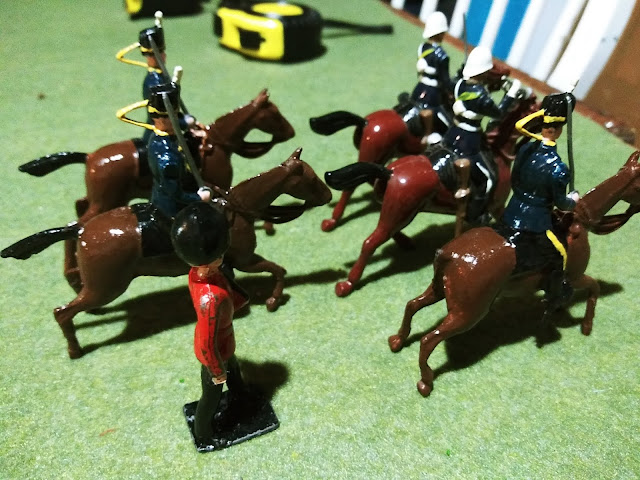After a extensive (manic, even) surveying of online markets, I was able to acquire an "Army Red" and "Army Blue" composed entire of Britains' 54mm toy soldiers (some are older hollow-casts and some are newer solid recasts). I already had acquired some of the firing 4.7" Naval Guns and had used those in
a Black Powder game in 2016 using Armies in Plastic 54mm figures. So rather suddenly, here I was with about 30 infantry, 12 cavalry and two guns to a side, all ready to play H.G. Wells'
Little Wars as written!
(Above: I forgot to take pics until the game was basically over. Here's Red closing in for the win. Note the Blue's Hussars being led away as prisoners at the bottom)
Although we are currently quarantined, I am fortunate to have a ready opponent. However, for this game I solo-gamed it, to get a feel for the rules. I was moving stuff around in the basement and prepping a wall for painting between shots of the 4.7s.
(Above: solid-cast Irish guards on the right, old hollowcast guards on the left. Notice how this particular 4.7" gun had to have its trail propped up to get a more level shot)
I use q-tips with the cotton buds cut off for ammunition for the guns. These become warped from hitting the houses fyiand then begin to fly irregularly! I have to admit it's an almost surreal experience to not use dice, although rather welcome and refreshing. Wells' melee rules is a sort of decision-tree of whether a force is outnumber and if it is, is it is "supported", in which case you may surrender, or fight and have prisoners taken but still incur a few casualties on the enemy.
(Above: Red's Essex Regiment, supported by old hollowcast guards,
move in on rapidly dwindling Blue forces)
In every ruleset I have read, this is the only one with a surrender mechanic. Why would a player prefer to surrender a melee than tough it out and inflict a few more losses on his opponent? It turns out that if both sides are reduced to 15 figures or less, and the main victory condition has not yet been met, the 100 points for winning the main victory condition is split 50/50 and you tally points as follows: (1) for each of your troops still on the table, 1 point for each infantry, 1.5 for each cavalry, 10 for each gun; (2) for each prisoner you have captured, half a point; and (3) for each figure
of yours who is a prisoner of the enemy, half a point.
(Above: Army Blue gun is manned by the King's Royal Rifles and Queen's Westminsters.
Some Scots Borderers had to fight on the side of Blue to make the forces equal.)
You receive zero points for enemy models killed. It would be possible, maybe, to be very aggressive, "lose" a bunch of melees but have more men taken prisoner than killed outright, and still win the game? Or at least hedge your bets in the event of a 50/50 split - you could win by half a point! Its definitely different than other rule sets.
There was also some testing of my various firing toy cannons to figure out which ones could depress elevation enough to not just shoot over the heads of the enemy all game. Two guns seem problematic, and require something placed under the trail (a spare 3mm thick MDF base worked well) to lower the barrel.
(Above: End-game, basically. The white-helmeted Red troops in lower-right will attack the Blue gun and result in death of men on both sides. This put both sides at less than 15 men, so it went to points, and Red won.)
(Above: Blue Hussar and Lancer prisoners being led to the rear.)
Next will be a "full" game with timed moves and two guns per side.




















































